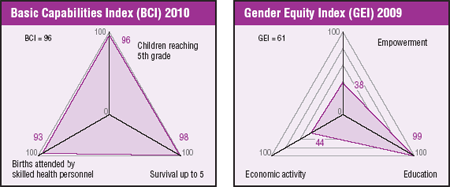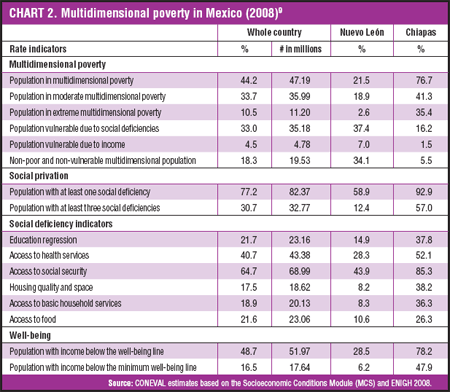Unequal progress
Equipo Pueblo [1]
Areli Sandoval Terán, and Espacio DESC
The official line is that Mexico is solidly on tract to reach the Millennium Development Goals (MDGs) by 2015. However, while there has been progress in health and education and a reduction in extreme poverty, many problems still remain, including serious inequalities across different regions of the country. In Mexico City, for example, has development rates comparable with some countries in Europe, but there are states in the south with indicators more like those of the poorest parts of the world. A study of how resources are applied shows that Mexico needs competent public management in public expenditure that is geared to the real priorities.
 |
Until the first half of 2010, there was little official information about Mexico’s progress towards the MDGs; the last available progress report was for 2006.[2] Using the 2005 Population and Housing Surveyand income, spending, employment, nutrition and health surveys from that year, the Federal Government at that time emphasized the progress that had been made since 1990 in extreme poverty reduction; reducing illiteracy; reducing the rates of HIV/AIDS, malaria and tuberculosis; reducing maternal mortality; improving gender equity in schools and extending access to potable water and sewage services.
However, the report also lists some problems that have not been tackled after years on the agenda. For example, it noted that not enough attention was being paid to environmental aspects of development policies, and that social policies were inadequate, since programs were not coordinated and the problem of deficient social protection, especially against unemployment and collective risks, had not been dealt with. It also pointed out that most of the budget and most of the programs targeted people employed in the formal sector, and that social exclusion posed a threat to the consolidation of democracy.
The 2006 progress report also contains some additional goals and indicators that are considered more suitable and relevant for Mexico as a middle-income country. For example, as regards Goal 1, the eradication of extreme poverty and hunger, and the first target, “to cut by half the percentage of the population whose income is less than one dollar a day in the 1990 to 2015 period”, the Government view is that the country is doing well in terms of the indicator of the proportion of the population with a per capita income of less than one dollar a day. It has therefore added a goal “beyond the Development Goals,” which is to cut by half, in the 1990 to 2015 period, the proportion of people suffering food poverty in rural and urban areas, which is still a big development challenge.[3]
Inequality
 |
Another big problem is inequality. UNDP reports on Mexico’s human development since 2002 show enormous differences among the 32 Federal States, particularly on the indicators for health, education and income. This despite the fact that Mexico is near the threshold of the more highly developed countries in terms of the Human Development Index (HDI).
The region with the highest HDI rating is the northeast, where one state, Nuevo León, is second only to the Federal District in terms of HDI and is nearly equal to some European countries. By contrast, the south has the lowest HDI ratings, particularly the states of Chiapas and Oaxaca, with indicators nearly as low than the occupied territories of Palestine. According to the UNDP these serious inequalities result from the fact that investment is precarious and that the local administration is fraught with cronyism and ineptitude, which hampers people from exercising their rights and enjoying full individual freedom. One consequence of the regional inequality is that there is a high level of internal and external migration; in fact, regional differences are such that “there are areas that offer better conditions of life than those prevailing in some people’s places of origin.”[4]
Poverty
The executive report on the 2007-2012 National Development Plan, which was drawn up by the National Council for Evaluating Social Development Policies (CONEVAL),[5] highlights the contrast between Chiapas and Nuevo León in terms of their food poverty rates, capabilities poverty rates and patrimony poverty rates.[6]
Financing for development strategy
 |
In the light of the social panorama outlined above and the economic crisis the country and the world are undergoing, we should also look at the ways in which the State applies the resources. According to an analysis of the fourth quarterly Treasury and Public Credit Secretariat report on the 2009 budget by the FUNDAR Analysis and Research Centre, both in planning and execution the Federal Government failed when it came to channelling resources in an effective and efficient way to reactivate the economy and protect the population. This report makes it clear that the resources essentials for social protection decreased while spending that benefited the bureaucratic apparatus increased. The tendency to under-expending resources in key secretariats continued until December (with big shortfalls for programs to fight poverty and for infrastructure projects).[9] Some of the most important points in this analysis include:
- Expenditure on infrastructure for social development fell by 14.5% in real terms compared to 2008; especially serious were reductions in urbanization, housing and regional development (21.4%) and in social assistance (56.7%).
- In the last quarter of 2009, contract remuneration under federal jurisdiction had an annual increase of 4.1% in nominal terms, the most noteworthy examples being in the areas of sovereignty, order, security and justice. By contrast, in October and November 2009, real pay for people employed in the manufacturing sector decreased by 0.6% per year: wages for workers fell by 2.1% and those of administrative employees by 0.8%.
- An annual budget execution progress report for 75 programs shows that only 24 executed 100% of their allocated budget and 23 more than 100% of the original allocation. It appears that only 32% of priority programs expend their budget allocations in time. The other 26 executed less than 90% of their original budgets. Among the programs that had low budget execution by the last quarter of 2009 were: a) a program to extend irrigation infrastructure, with only 33.2% ; b) economic infrastructure projects for potable water, sewage and sanitation systems, with 39.5%; c) a food support program administered by Diconsa, with 69.6%; d) rural roads, with 73.5%; e) the education component of the opportunities program with 79.5%; f) the provision of health services at various levels with 85.2%; d) the potable water, sewage and sanitation program for urban areas, with 86.4% .
This means that of the MXN 188,395 million (USD 14,848 million) allocated to the main programs to combat poverty some USD 1,322 million has not been expend. The worst examples of this resource under expenditure are in the food support program run by Diconsa S.A. of C.V.– a company devoted to social development, whose major stakeholder is the State – the employment support program, the young rural entrepreneurs program and the land fund, in which the payment shortfalls amount to 30%, 38% and 56%, respectively. There have also been under expenditures in key secretariats, the most serious ones being health, which expend USD 784 million less than the modified budget up to December 2009, and the Social Development Secretariat with an under expenditure of USD 306 million.
These examples do not just illustrate how defective the management of public resources is in Mexico, they also highlight the fact that the State’s obligation to allocate the maximum available resources to progressively achieve implementation of the rights stipulated in the International Covenant on Economic, Social and Cultural Rights goes much further than merely allocating budget resources for social development and poverty reduction. There also has to be competent public management of State funds so that genuine national priorities receive resources in ways that are congruent and transparent.
[1] Equipo Pueblo is the focal point of Social Watch in Mexico and is part of Espacio DESC, the reference group for Social Watch.
[2] Social and Human Development Cabinet, Los Objetivos de Desarrollo del Milenio en México: Informe de Avance 2006, Mexico City, 2006. Available from: <www.objetivosdelmilenio.org.mx/PDF/ODM%202006.pdf>.
[3] Food poverty was defined by the Technical Committee for Poverty Measurement (CTMP) as the inability to obtain a basket of basic foodstuffs with the total disposable household income.
[4] UNDP, Informes sobre Desarrollo Humano en México, 2006-2007. Available from: <www.undp.org.mx>.
[5] CONEVAL, Informe Ejecutivo de Pobreza en México, June 2007. Available from: <www.coneval.gob.mx>.
[6] Capabilities poverty was defined by the CTMP as having insufficient disposable income to pay for a foodstuffs basket and afford the necessary expenditure for health and education even when all the disposable income of the household is spent on these things. Patrimony poverty was defined as having insufficient disposable income to pay for the food basket and to be able to afford the minimum expenditure needed for health, clothing, housing, transport and education, even when all the disposable income of the household is spent exclusively on acquiring these goods and services.
[7] Methodology of Multidimensional Measurement of Poverty in Mexico. Available from:
<www.coneval.gob.mx/contenido/med_pobreza/8803.pdf>.
[8] <www.coneval.gob.mx>.
[9] FUNDAR, “Informe Sobre la Situación Económica, las Finanzas Públicas y la Deuda Pública,” No. 99, February 2010. Further information in: <www.fundar.org.mx>.
| Attachment | Size |
|---|---|
| mexico2010_eng.pdf | 211.41 KB |